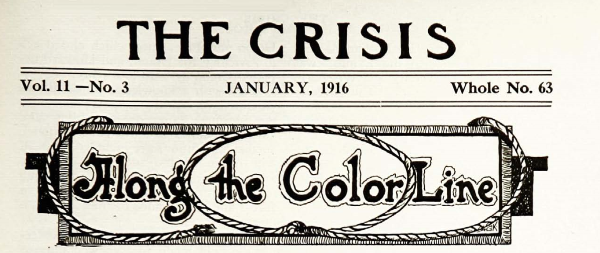A short essay follows the maps, explaining the origin and method of the "Along the Color Line" feature. (Here are other NAACP maps and data) These maps are hosted by Tableau Public and may take a few seconds to respond. If slow, refresh the page.
Source:The Crisis, August 1916-Juny 1917, edited by W.E.B. Du Bois: the collection of miscellaneous news initially titled Along the Color Line then renamed The Horizon.
As editor of the NAACP’s in-house magazine The Crisis, Du Bois made sure the magazine engaged the major events of his time. As circulation increased, the monthly became a powerful voice spreading not only the NAACP’s message, but also tying together local movements and local Black presses. Many of the major stories it contains were in-depth reports, and it is perhaps best known for its investigative journalism into lynching, as in the July 1916 special issue on “The Waco Horror.” However, long-form journalism took up relatively few pages of The Crisis. When reading whole issues, other components of the magazine demand attention. One such component is the monthly miscellany, “Along the Color Line,” which was renamed “The Horizon” in August, 1916. Du Bois understood the importance of the interplay between grand-scale history and the everyday events of African-American life. “Along the Color Line,” printed short articles gathered from around the country and around the world. He understood that print can transmute events into shared experiences for readers “to or become intelligent about or aroused over” (January 1916,p. 135). The maps above reproduce these 1800 short articles geographically, re-presenting Du Bois’ aggregated account of African-American life in the nineteen-teens.
As printed in The Crisis, “Along the Color Line” and “The Horizon” are a collection of micro-articles presented in double columns, under various subject headings. The feature was a venue for communities to self-report their activities to The Crisis . Many items were sent by NAACP members and chapters. Others were clipped by African American newspapers. As such, it made community news into national news. The snippets of information in “Along the Color Line” range from the relatively minor—about a boy winning a skating competition, or the deaths of notable community members—to the major, including a running commentary and recording every lynching that came the magazine’s notice, regardless of the race of the victim. The miscellany gathers momentum with each entry, as each frame of information starts to come together to sketch out a moving picture of the life of the Black community in the nineteen-teens. It also reveals much about the concerns of the NAACP at the time, and the keen eye of Du Bois. At this key moment when the NAACP multiplied in size and came into its own as a major national movement, The Crisis devoted around a sixth of its total pages to “Along the Color Line” and “The Horizon.”
The Crisis categorized the entries under repeating headings: Athletics, Crime, Economics, Education, Foreign, General, Ghetto, Industry, Meetings, Military, Music and Art, Personal, Politics, Social Progress (Uplift), The Church, and eventually, The War. As such, it was an attempt to examine life through these many angles. Almost every entry contains geographic information, locating each event that it describes. These features mean that “Along the Color Line” and “The Horizon” are a database tagged by category, geographic location and date: something that invited the creation of these maps. Mapping “Along the Color Line” transmutes columns of text into visuals. The distribution of events shows the national and international scope of the miscellany.
Each entry is only a few sentences long, but they contain a rich trove of information. Entries are no more than a terse paragraph, resembling nothing so much as a tweet, informing the reader of some happening deemed to be worth reporting to the community. Most contain the location of the event as well. Their position in a monthly magazine means they are also tagged with a date—the month of publication. Most entries have happened within a month or two of publication, and the constant rotation of entries means that the news in the miscellanies stayed fresh. Reading these entries a century later gives a sense of embedded, real-time knowledge of events.
While these maps are primarily here to present the miscellanies from the early days of The Crisis in a more visual and interactive manner than the pdfs on archival sites, they also reveal spatial patterns when the dots representing individual entries begin to cluster, or when very few appear in other regions. The West Coast is relatively sparse, though events occur, especially in the cities. Major cities across the country draw many mentions, but so do the villages and small towns, particularly in the South. Unsurprisingly, the Historically Black Universities often draw multiple mentions in every issue.
“Along the Color Line” and “The Horizon” contain many entries that will resonate with contemporary readers: accounts of voter suppression, unequal policing, lynching under the eyes of the law, controversies over migration and immigration, unequal education, tension with the white working class’ labor movements, and many other topics appear in its pages. It also records notes on new art, music, academic achievements, infrastructure, industrial progress, lives and deaths of significant men and women, and progress made by the NAACP. Our maps currently contain 1782 entries drawn from these columns, a number which may rise in the future.
These maps attempt to make “Along the Color Line” and “The Horizon” more accessible to present-day readers. Presenting local and monthly history of the smaller scale on a map rather than in The Crisis’ double columns makes this information more interactive and visual. While the contents of each entry have their inherent historical interest, it is also important to see this as a study in method aligned with many current civil rights initiatives: publication and publicity were important then as now.
(Here are other NAACP maps and data)
Research and data compilation: Tyler Babbie
Maps: Tyler Babbie, James Gregory

